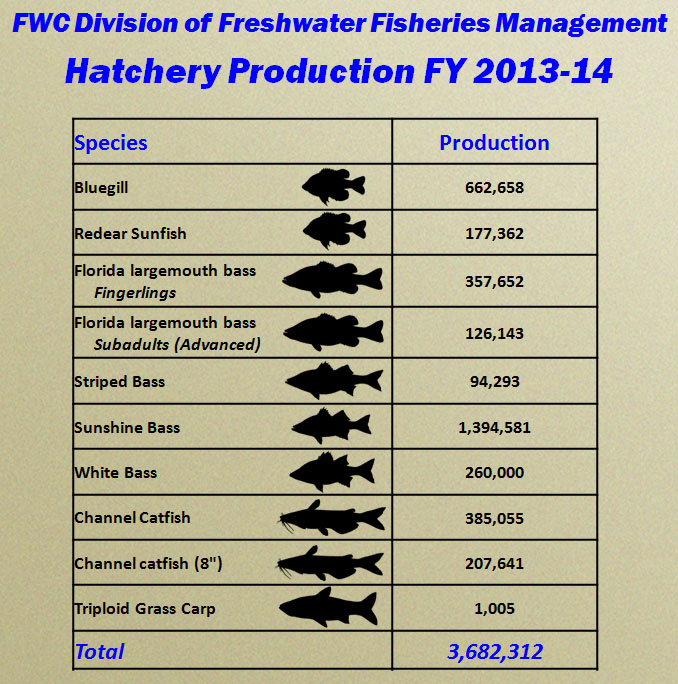November 04, 2014
By FWC Freshwater

The Blackwater Fisheries Research and Development Center (Holt County) and the Florida Bass Conservation Center (Sumter County) have completed their annual freshwater fish hatchery production for FWC's Division of Freshwater Fisheries Management (DFFM) for Fiscal Year 2013-2014. During the last year (July 1, 2013 to June 30, 2014), both hatcheries stocked over 3.6 million fish for recreational fishing in Florida's lakes and rivers. That number is slightly higher than the number released during the previous fiscal year. Hatchery production included nine species, incorporating both warm- and cool-water species. These included striped bass, both Palmetto and Sunshine Bass hybrids, two distinct sizes of Florida largemouth bass, white bass, bluegill, redear sunfish and channel catfish. Triploid grass carp (a sterile herbivorous species that are used to control aquatic vegetation) used at the hatcheries were also relocated for agency invasive aquatic plant control programs elsewhere in the state.

The DFFM maintains stocking programs for Florida largemouth bass to enhance reproduction or to reintroduce bass into lakes that are recovering from severe low water conditions. Two major lakes received considerable attention this year with large stockings of genetically pure Florida largemouth bass. Orange Lake in Alachua County, which had suffered significant fish kills during recent low water, was restocked with over 300,000 bass during the spring. In total 102,333 four- to five-inch Florida largemouth bass sub-adults and an additional 200,000 7-day-old fry were transported to different areas of the lake and released. Lake Pierce in Polk County was also stocked with over 160,000 advanced sub-adults this spring in an effort to boost the bass population. The FWC will monitor the survival of these stockings by the use of genetics to identify hatchery vs. wild bass by simply clipping a small piece fin from all sampled bass and analyzing the genetic information in each fin. Release of larger advanced sub-adults is intended to utilize larval threadfin shad and other forage species as a food source to improve survival. This gives these advanced sub-adults a foraging advantage. North Florida anglers benefited this year from release of over 94,000 Gulf striped bass into the Blackwater River and Lake Talquin areas. Statewide, the FWC released almost 1.4 million Palmetto and Sunshine Bass, which are a hybrid between the striped bass and white bass. The Apalachicola River and Escambia River in north Florida received in excess of 650,000 hybrids, while the Osborne Chain of Lakes in southeast Florida, Kissimmee River, and Caloosahatchee River in southwest Florida also received significant numbers of hybrids. With the assistance of the United States Fish & Wildlife Service (USFWS) Welaka National Fish Hatchery, over 375,000 striped bass Hybrids were also released along two areas of the St. Johns River.


